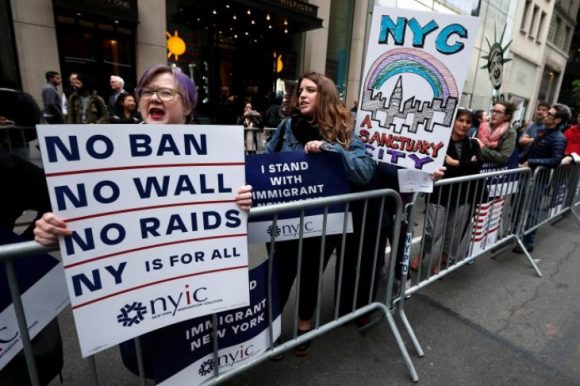Dear Commons Community,
The New York Times has a featured article this morning on how the big tech companies namely Microsoft, Google, and Apple are developing products to capture the lucrative K-12 technology market that is expected to reach $21 billion by 2020. The article focuses mainly on Microsoft’s strategy to develop low cost/high tech experiments that teachers can use in classrooms. Here is an excerpt:
“Last week, Satya Nadella, the chief executive of Microsoft, slipped on a glove made of cardboard and clenched his hand into a fist, causing a robotic hand with fingers made of drinking straws to mimic his movements.
The glove was one of several engineering projects built in a makeshift laboratory on Microsoft’s campus. The company spent the last year talking to thousands of teachers and designing high-tech experiments that require mostly low-cost parts. It will give the designs to schools for free so teachers can use them in their lesson plans.
The projects are part of a major push the company announced Tuesday at an event in New York to make its products more attractive to school administrators, students and teachers. The push includes a new version of Microsoft’s Windows operating system for classrooms, tweaks to its Office applications and a new Surface laptop for students in a collection of bold colors.
While the dollars available in the education market are compelling enough for big technology companies like Microsoft, classrooms also offer an opportunity to make a first impression on young people who could eventually buy their products.
“The second-order effects of education, of being relevant in education, are going to be very, very key for us,” Mr. Nadella said in an interview last week. He added, “The devices the kids take to their school, or to their college, is going to be influenced by what they were familiar with.”
Microsoft remains a force in classrooms around the globe. But the company’s relevance in schools in the United States is in jeopardy after years of progress by Google, whose software dominates sales of new devices in schools.
Google has gained ground in public schools by offering a tightly connected system of free classroom apps, lower-cost laptops called Chromebooks and a web-based console that allows schools to remotely manage thousands of student devices.
Industry analysts said Microsoft’s initiative was the company’s first credible response to Google’s recent encroachment into education.
“I am not going to predict that they are going to take back the entire market or anything like that, but this is the best move that I could have seen them making against Chromebooks,” said J. P. Gownder, a technology analyst at Forrester Research, a market research company, where Microsoft is one of his clients.
Some of Microsoft’s moves are intended to make its products more appealing to educators by simplifying them and, in some ways, restricting them. The new version of its operating system, Windows 10 S, will run only applications that have been vetted by Microsoft and placed in its online app store, to prevent students from downloading software that could slow the performance of their computers.
Microsoft has also devised a way for schools to get new computers running on a network quickly, without manually configuring each one, by plugging in a USB memory stick. A Microsoft management system called Intune for Education allows schools to set further limits on classroom computers, like locking them down so students cannot cheat by surfing the web during tests.
The tools are designed to be easy enough for teachers to use, since many schools do not have dedicated technology administrators. “Sometimes school districts aren’t managing the devices,” said Terry Myerson, a Microsoft executive vice president. “Teachers are on the front lines of managing the devices.”
The company is also making full versions of its Office applications, rather than more limited web versions, available to schools for free. It has modified a version of its Microsoft Teams group-chat tool so teachers can collaborate with students. It is also waiving the cost of an educational version of Minecraft, a popular video game it owns, for the first year schools use it.
While much of Microsoft’s focus is on software that makes using inexpensive devices — often in the $200 to $300 range — more palatable, the company will also release a $999 device called the Surface Laptop, a twist on its Surface tablets. The device will run Windows 10 S.
Tech companies are fiercely competing for business in primary and secondary schools in the United States, a technology market expected to reach $21 billion by 2020, according to estimates from Ibis Capital, a technology investment firm, and EdtechXGlobal, a conference company.
It is a matter of some urgency for Microsoft.
Chromebooks accounted for 58 percent of the 12.6 million mobile devices shipped to primary and secondary schools in the United States last year, compared with less than 1 percent in 2012, according to Futuresource Consulting, a research company. By contrast, Windows laptops and tablets made up 21.6 percent of the mobile-device shipments to schools in the United States last year, down from about 43 percent in 2012.
Outside the United States, Microsoft Windows devices accounted for about 64 percent of mobile-device shipments to schools last year, Futuresource said.
Apple has similarly experienced a steep Chromebook-related decline in shipments of iPads and Mac laptops to schools. Its mobile shipments to schools fell to 19 percent in the United States last year, from 52 percent in 2012.
Like Microsoft, Apple is not taking the Chromebook phenomenon lying down. Apple recently introduced an iPad management app called Classroom, which enables teachers to assign shared iPads to students and create virtual classrooms to guide students through lessons. Apple also introduced lower pricing for educational institutions on its newest iPad model. The iPad starts at $329 for consumers and at $299 for schools.
Google began to take off in schools in the United States in 2013, when school districts started making bulk purchases of Chromebooks, which are now made by Acer, Asus, Lenovo, HP and other computer makers. Because the laptops run on Google’s Chrome operating system and revolve around web-based apps, they are often cheaper, easier to manage and faster to boot up than traditional laptops.
By contrast, Mr. Gownder of Forrester Research said that Microsoft software is so feature-rich that technology experts in many school districts have had to devote their summers to preparing Windows laptops for students one device at a time.
And some of Microsoft’s initial attempts to contend with Google’s rise in schools stumbled. In 2014, Microsoft announced it would be going head-to-head with Chromebooks by working with device manufacturers to introduce cheaper Windows laptops. But some schools found the lower-priced Windows devices too cheaply made to withstand student use and too low-powered to efficiently run Microsoft software.
“The cheapest of them would not work,” said Hal Friedlander, a former chief information officer of the New York City Department of Education.
Google began to win the classroom software wars as well. In 2014, the company introduced Google Classroom, an app that teachers could use to digitize daily tasks, like assigning homework or taking attendance. It quickly became a hub where teachers could hold class discussions, communicate with individual students and keep parents updated on classroom news.
While Microsoft had successfully developed a loyal following among teachers for certain tools — like Skype and its OneNote notebook organizer program — the company had no answer for the classroom management system, which Google had developed specifically for teachers.
“The challenge for Microsoft is that it did not seem to have a coherent strategy,” said Mr. Friedlander, who is now chief executive of the Technology for Education Consortium, a nonprofit group that promotes transparent pricing for technology sales to schools.
Officials at Omaha Public Schools, which spends about $570,000 annually on Microsoft software and is investing $8 million to buy students Windows devices, welcomed the company’s more comprehensive approach to the classroom.
About 200 teachers in the district have completed professional development activities called the Microsoft Innovative Educator program. Some of those teachers are already using the Microsoft Teams chat service with their students.
“Now it’s not four or five different experiences based on which app you are using,” said Rob Dickson, the executive director of information management services for Omaha Public Schools.
“It’s a single app with all those experiences within it.”
For those interested in instructional technology, the article contains good insight into corporate strategies in cornering the K-12 education market. I especially thought the analysis of Google and its success with its Chromebooks product was well done.
Tony









